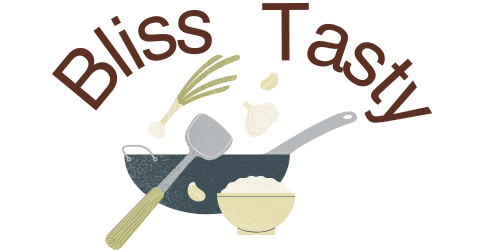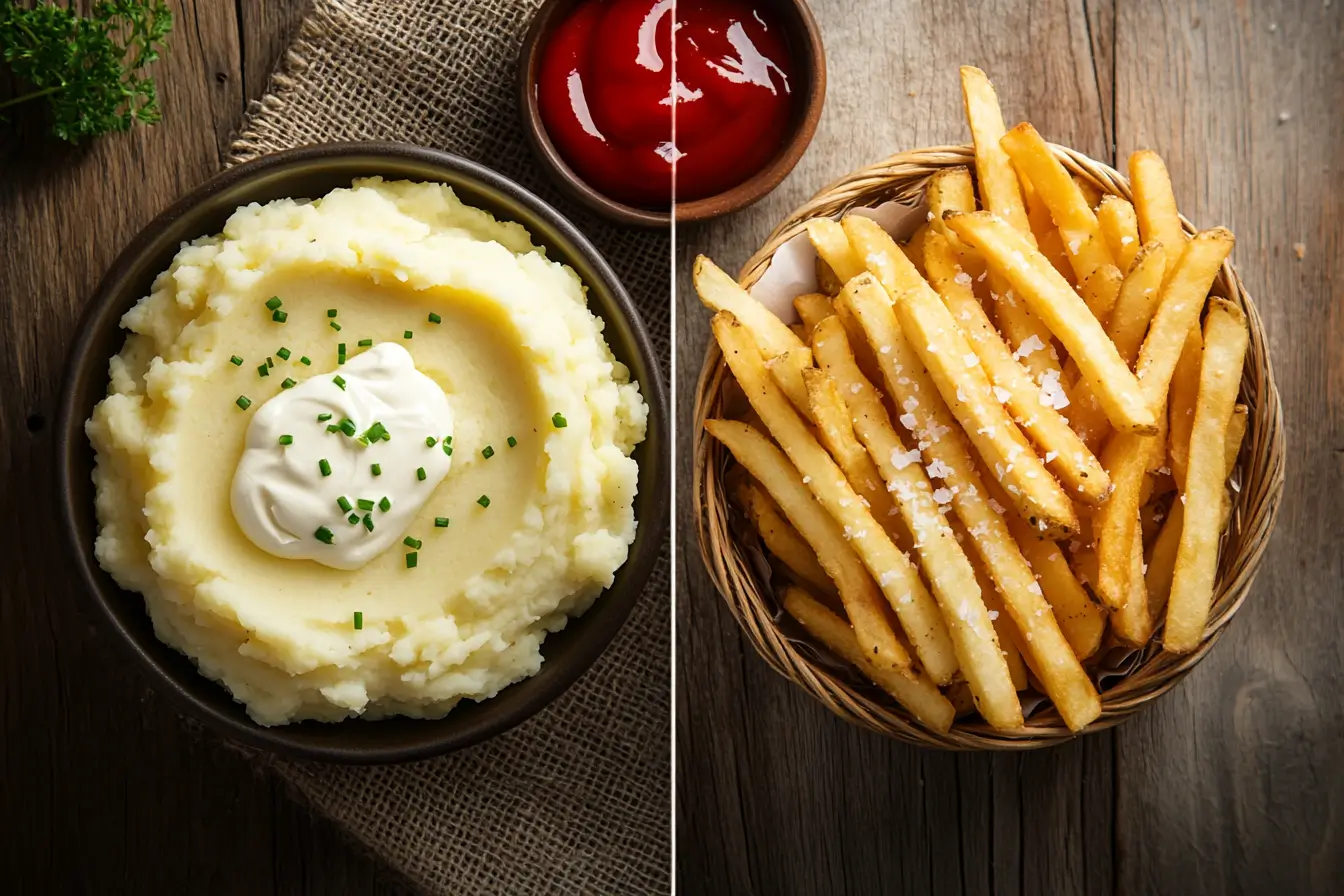Ah, potatoes—America’s most versatile comfort food. Whether you’re grabbing a quick snack or whipping up a holiday feast, potatoes are a go-to. But when it comes to mashed potatoes and French fries, these two favorites couldn’t be more different. I mean, yeah, potatoes make them both, but they’re practically cousins at a family reunion—sharing similar roots but flaunting wildly different personalities.
In this blog, I’ll break down everything that distinguishes these two, including their texture, flavor, preparation methods, and ideal serving occasions. Plus, we’ll answer some FAQs because, let’s be honest, we all have some burning questions about our favorite spuds.
The Basics: What Are Mashed Potatoes and French Fries?
Let’s start with the obvious: mashed potatoes are soft, creamy, and perfect for scooping. French fries, on the other hand, are crispy, salty, and downright addictive.
mashed potatoes and French fries
Cooks make mashed potatoes by boiling potatoes until they are soft, mashing them (duh), and mixing in ingredients like butter, milk, or cream. They usually serve them as a side dish—think Thanksgiving dinner or Sunday roast. The texture is smooth and creamy (or lumpy, if that’s your thing). The flavor? Subtle, buttery, and comforting.
French fries are thinly sliced potatoes that are deep-fried until golden and crispy. They’re a staple of fast food and backyard barbecues, served with ketchup, mayo, or even chili and cheese. Unlike mashed potatoes, fries are all about crunch.
How They’re Made mashed potatoes and French fries
Both mashed potatoes and fries start with—you guessed it—potatoes. But the preparation process couldn’t be more different.
Making Mashed Potatoes
- Peeling and Chopping: You peel the potatoes (unless you like the rustic look) and chop them into chunks.
- Boiling: Toss the chunks into boiling water until they’re fork-tender.
- Mashing: Use a masher or even a ricer if you’re feeling fancy. Add butter, milk, salt, and pepper.
- Mixing: Stir until you get your preferred consistency.
Peel and chop the potatoes, boil until soft, then mash with butter, milk, and seasonings. Yukon Golds or Russets are perfect for creating smooth and creamy mashed potatoes. If you’re looking to add an herbal twist, try this recipe for rosemary mashed potatoes for a vibrant flavor boost.
Making French Fries
- Cutting: Slice the potatoes into strips—skin on or off, your call.
- Soaking: Soak the strips in cold water to remove excess starch.
- Drying: Pat them dry to get that perfect crispiness.
- Frying: Deep-fry in hot oil, then let them cool. Fry them again for extra crunch.
- Seasoning: Toss with salt while they’re still hot.
Pro Tip: Double-frying is the secret to crispy perfection. First at a lower temp to cook the potato, then at a higher temp to get that crunch.
Texture and Taste of mashed potatoes and French fries
Here’s where things get interesting.
Mashed Potatoes
The texture is all about smoothness. They’re fluffy, soft, and melt-in-your-mouth delicious. The flavor depends on what you add—think garlic, sour cream, or even cheese.
French Fries
Crispy on the outside, soft on the inside. The taste is salty and savory, but you can spice things up with cajun seasoning, truffle oil, or parmesan.
When to Serve Them
Both mashed potatoes and fries have their time and place.
- Mashed Potatoes: shine as a side for hearty meals like turkey or roast beef. For a complete comfort meal idea, try pairing them with ground beef and mashed potatoes, a dish that’s both filling and flavorful.
- French Fries: Best for casual meals—think burgers, hot dogs, or fried chicken. They’re the life of the party when served as a snack or appetizer.
Health Factor: Which Is “Better” mashed potatoes Or French fries?
Neither of these is a kale smoothie, but hey, life’s about balance.
Mashed Potatoes
Mashed potatoes can be relatively healthy—if you skip the heavy cream and butter. A basic mash is lower in calories than fries and has less fat.
French Fries
Fries are deep-fried, which means they’re higher in calories and fat. But let’s be real—they’re worth every bite. If you’re looking for a lighter option, try baking or air-frying them.
Fun Facts About Mashed Potatoes and French Fries
- Mashed Potatoes: Did you know the first recorded mashed potato recipe dates back to 1747 in England? Talk about a classic.
- French Fries: Despite the name, French fries actually originated in Belgium. And yes, the French and Belgians are still debating who did it first.
Mashed Potatoes vs. French Fries: A Texture Showdown
One of the biggest reasons people are drawn to either mashed potatoes or French fries is texture. Mashed potatoes offer that warm, pillowy softness we associate with comfort food. They’re smooth (or lumpy if you like some texture) and feel like a cozy blanket for your taste buds. On the flip side, French fries bring the crunch—there’s something so satisfying about biting into a golden fry and hearing that little crackle. Texture alone can influence what people are in the mood for, whether it’s a comforting side for a heavy meal or a crunchy snack to munch on during a game.
Why Do Mashed Potatoes Feel More “Homemade”?
Let’s be real, mashed potatoes give off strong grandma’s-kitchen vibes. Maybe it’s because they’re a labor of love—you have to peel, boil, and mash them by hand (even if you cheat with a mixer). There’s something so personal about tweaking the recipe with your own ratio of butter, milk, and seasonings. French fries, on the other hand, feel a little more, well, industrial. Sure, you can make fries at home, but most of us grab them from a drive-thru or the frozen aisle. Mashed potatoes scream “made from scratch,” while fries feel more like a convenience food.
Seasonings and Toppings: Customizing Your Potatoes
Here’s where both mashed potatoes and fries really shine—you can dress them up in so many ways! For mashed potatoes, people love to add garlic, herbs like rosemary or chives, and sometimes even bacon bits or shredded cheese. French fries are just as customizable: think truffle fries, chili cheese fries, or even fries dusted with Old Bay seasoning. The versatility of both dishes is a huge part of their charm—you can keep it simple or go all-out gourmet.
How Do Leftovers Hold Up?
Let’s talk leftovers, because we’ve all been there—too many mashed potatoes after Thanksgiving or a box of soggy fries the next day. Mashed potatoes are definitely more forgiving. You can reheat them with a splash of milk or cream, and they’re nearly as good as fresh. Leftover French fries, though? Tricky. They tend to lose their crispiness unless you reheat them in an oven or air fryer. So, if you’re planning ahead, mashed potatoes win the leftover game hands down.
A Battle of Dips and Add-Ons
Let’s not forget how much fun you can have with dipping sauces and add-ons! French fries practically demand to be paired with something—classic ketchup, mayo, or even ranch dressing. Mashed potatoes are a bit more restrained, usually served with gravy or a dollop of butter. Both are tasty, but fries are clearly the champion of variety when it comes to sauces.
Cultural and Regional Preferences
It’s interesting to see how mashed potatoes and French fries are viewed differently across the U.S. and around the world. In the U.S., mashed potatoes are the king of holiday tables, while fries are a fast-food staple. In the U.K., fries (or “chips”) are served alongside fish, and mashed potatoes often come with sausages (“bangers and mash”). Each dish has its cultural moment, but fries definitely have a more global appeal when it comes to quick eats.
Are Fries or Mash Better for Kids?
If you’re feeding picky eaters, the answer might depend on their age. Mashed potatoes are often a hit with younger kids because they’re easy to eat and don’t require any chewing. Fries, with their crispy texture and fun shapes (hello, waffle fries and curly fries), might appeal more to older kids or anyone who loves finger food. Either way, both can be kid-approved with the right seasoning or sides.
FAQs IN Difference between mashed potatoes and French fries
1. Can you use the same potatoes for both?
Yes, Russets and Yukon Golds work for both mashed potatoes and fries. However, Russets are ideal for fries because they’re starchy and get super crispy. Yukon Golds are better for mash because they’re naturally creamy.
2. What’s the best oil for frying fries?
Go for oils with a high smoke point, like peanut, canola, or sunflower oil. They’ll give you that perfect golden-brown finish.
3. Can mashed potatoes be made ahead of time?
Absolutely! Just store them in the fridge and reheat with a splash of milk or cream to bring back the creaminess.
4. Why do fries get soggy?
Fries get soggy if they’re not fried at the right temperature or if they’re left sitting too long. Double-frying and serving immediately are key.
5. Can you make healthier versions of both?
Sure thing! Bake your fries instead of frying, and use skim milk or olive oil in your mashed potatoes.
Final Thoughts on mashed potatoes and French fries
So, there you have it—the lowdown on mashed potatoes and French fries. Whether you’re in the mood for creamy comfort or crispy indulgence, these potato dishes have got you covered. Honestly, why choose? Have both and call it a day.


1 thought on “What’s the Difference Between Mashed Potatoes and French Fries?”